Europeans: Discover the Smart Way to Trade US Options
Learn how European investors can trade US options easily — beginner strategies, step-by-step setup, tax tips & tools to visualize profits.
OPTIONS TRADING
Ben T.
11/2/202519 min read


Options 101 — What They Are and Why They Matter (Especially for Europeans)
If you're a European investor, chances are you've heard of CFDs (Contracts for Difference) — a popular way to speculate on price movements without owning the underlying asset. But there's another powerful tool used widely in the US: options.
Options might sound complex at first, but once you understand the basics, they open up a world of strategic possibilities — from generating income to protecting your portfolio.
Let’s break it down simply.
🔍 What Is an Option?
An option is a financial contract that gives you the right, but not the obligation, to buy or sell a stock at a specific pricebefore a certain date.
There are two types:
Call Option: Gives you the right to buy a stock at a set price (called the strike price).
Put Option: Gives you the right to sell a stock at a set price.
Think of it like reserving a hotel room. You pay a small fee (called the premium) to lock in a price. If the price goes up, you benefit. If not, you can walk away — you’re not obligated to stay.
🧮 Key Terms Made Simple
Here are the essential terms you’ll see in options trading:
Strike Price: The price at which you can buy/sell the stock.
Expiry Date: The deadline by which you must decide to use the option.
Premium: The cost of buying the option.
Intrinsic Value: The real value of the option if exercised now.
Extrinsic Value: The “time value” — what traders pay for potential future movement.
Greeks (used to measure risk and behavior):
Delta: How much the option price moves when the stock moves.
Gamma: How much Delta changes as the stock moves.
Theta: How much value the option loses each day (time decay).
Vega: How sensitive the option is to changes in volatility.
⚖️ Options vs. CFDs — What’s the Difference?
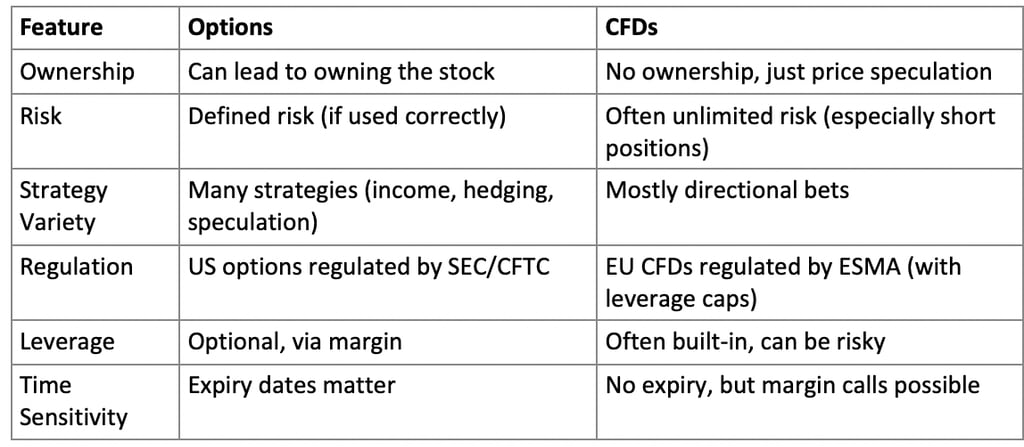

Tip: Options offer more flexibility and risk control than CFDs — especially for income strategies like selling puts or covered calls.
💡 Why Trade Options?
Options are popular in the US for good reason. Here’s what they can do for you:
Generate Income: Sell options to collect premiums — like renting out your stocks.
Protect Your Portfolio: Buy puts to hedge against market drops.
Buy Stocks Cheaper: Use cash-secured puts to potentially buy stocks at a discount.
Boost Returns: Use spreads to earn income with limited risk.
Speculate Smartly: Bet on price moves with defined risk.
📈 Real-World Example: Buying a Call Option
Let’s say you think Apple (AAPL) will go up.
You buy a call option with a strike price of $280, expiring in 30 days.
You pay a premium of $3 per share (options are sold in lots of 100 shares, so $300 total).
If AAPL rises to $290, your option is worth $10 per share — a $700 profit.
If AAPL stays below $280, you lose the $300 premium — that’s your maximum loss.
Pro Tip: Options let you control 100 shares of stock with a fraction of the cost — but you must manage time and volatility.
🎯 Common Option Use Cases — How Real Investors Use Options
Options aren’t just for Wall Street pros or day traders. In fact, many retail investors — especially in the US — use options to enhance their portfolios, generate income, or protect against losses.
Here are the most common ways options are used, with simple examples to help you understand how they work in practice.
1. 🛡️ Hedging — Protecting Your Investments
Use Case: You own stocks and want to protect against a sudden drop.
Strategy: Buy a put option on the stock you own.
Example:
You own 100 shares of Tesla (TSLA) at $450.
You buy a put option with a strike price of $440, expiring in 30 days, costing $4 per share.
If TSLA drops to $420, your put option gains $20 per share — offsetting your stock loss.
If TSLA stays above $440, you lose the $400 premium — but your stock is safe.
Why it matters: This is like buying insurance for your portfolio.
2. 💰 Income Generation — Getting Paid to Wait
Use Case: You want to earn income while waiting to buy or sell stocks.
Strategy: Sell cash-secured puts or covered calls.
Example 1 — Cash-Secured Put:
You want to buy Apple (AAPL) at $270 (suppose current price at $275).
You sell a put option with a strike of $270, expiring in 30 days, and collect $2 per share.
If AAPL drops to $270, you’re obligated to buy — but you keep the $200 premium.
If AAPL stays above $270, you keep the premium and don’t buy the stock.
Example 2 — Covered Call:
You own 100 shares of Microsoft (MSFT) at $520.
You sell a call option with a strike of $530, expiring in 30 days, and collect $3 per share.
If MSFT stays below $530, you keep the premium.
If MSFT rises above $530, your shares are sold at that price — but you still keep the premium.
Why it matters: These strategies let you earn passive income while managing your stock positions.
3. 📊 Speculation — Betting on Price Moves with Defined Risk
Use Case: You want to profit from a stock move without buying the stock.
Strategy: Buy call or put options, or use spreads for limited risk.
Example — Buying a Call:
You think NVIDIA (NVDA) will rise.
You buy a call option with a strike of $200, expiring in 30 days, costing $10 per share.
If NVDA rises to $220, your option is worth $20 — a $1,000 profit.
If NVDA stays below $200, you lose the $1,000 premium.
Example — Credit Spread:
You sell a put option at $150 and buy another at $145.
You collect $1.50 per share upfront.
Your maximum loss is $3.50 per share (difference between strikes minus premium).
If the stock stays above $150, you keep the full premium.
Why it matters: Options let you speculate with defined risk, unlike CFDs which can have unlimited downside.
4. 🔄 Replacing Stock — Using Options Instead of Buying Shares
Use Case: You want exposure to a stock but don’t want to tie up capital.
Strategy: Buy deep-in-the-money call options.
Example:
Instead of buying 100 shares of Amazon (AMZN) at $230 ($23,000 total), you buy a call option with a strike of $100, expiring in 6 months, costing $35 per share ($3,500 total).
You get similar upside exposure with less capital.
If AMZN rises to $250, your option is worth $50 — a $1,500 profit.
Warning: This strategy involves time decay and volatility risk. It’s best for experienced traders.
✅ Summary of Use Cases


Tip: Start with income strategies like cash-secured puts and covered calls — they’re beginner-friendly and don’t require margin or complex setups.
🛂 Regulatory & Practical Reality for Europeans Trading US Options
If you're a European resident interested in trading US options, the good news is: it's possible and legal, but there are important regulatory, broker, and tax considerations to understand first.
Let’s break it down
✅ Can Europeans Legally Trade US Options?
Yes — European retail investors can legally trade US-listed options through brokers that accept international clients. There are no EU-wide bans on options trading like there are for binary options or highly leveraged CFDs. [esma.europa.eu]
However, you must use a broker that:
Is regulated and licensed in its jurisdiction.
Complies with MiFID II and local financial laws.
Offers transparent risk disclosures and proper onboarding.
Tip: Unlike CFDs, which are heavily restricted by ESMA due to high leverage and retail losses, options offer defined risk and are often seen as more responsible tools when used correctly.

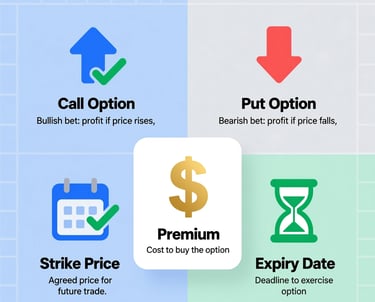
🌍 Tastytrade Availability for EU/UK Residents (November 2025)
Tastytrade is one of the few US-based brokers that accepts European clients. Here’s what you need to know:
Eligible Countries: Most EU countries and the UK are supported, including Austria, Belgium, Czech Republic, Denmark, Estonia, Finland, France, Germany, Greece, Hungary, Ireland, Italy, Netherlands, Poland, Portugal, Spain, Sweden, and the UK.
Restricted Countries: Some countries like Russia, Ukraine, Belarus, and Malta are currently not supported.
Account Types: You can open individual cash or margin accounts. Entity accounts are not available for international clients.
KYC Requirements:
Valid passport or driver’s license
Proof of address (utility bill, bank statement, or government-issued ID with address, less than 1 year old)
Funding:
Must be in USD
Use wire transfer or ACATS (no credit cards or PayPal)
Use services like Wise, Revolut, or OFX to convert EUR/GBP to USD before sending
Minimums:
No minimum to open a cash account
$2,000+ required for margin privileges
📉 Pattern Day Trading Rule (PDT)
If you open a margin account, be aware of the PDT rule:
If you make 4 or more day trades in 5 business days, your account is flagged as a Pattern Day Trader.
To continue day trading, you must maintain $25,000+ in equity.
If you fall below that, your account may be restricted to closing-only trades.
Warning: This rule applies even if you didn’t intend to day trade. It’s best to start with a cash account to avoid PDT restrictions.
💱 Currency Conversion & FX Risk
Since Tastytrade only accepts USD deposits, you’ll need to convert your local currency before funding your account.
Options for conversion:
Tip: Compare fees and exchange rates before converting. Even small differences can impact your trading capital.
🧾 Tax & Reporting Considerations
Trading US options from Europe has tax implications. While Tastytrade does not withhold US taxes on capital gains, you may be subject to:
Capital gains tax in your home country
Dividend withholding tax (if you own US stocks via assignment)
Foreign income reporting requirements
Currency gains/losses from USD/EUR or USD/GBP fluctuations
Important: Always consult a local tax advisor. Tax rules vary widely across Europe.
📋 Summary: What You Need to Trade US Options from Europe
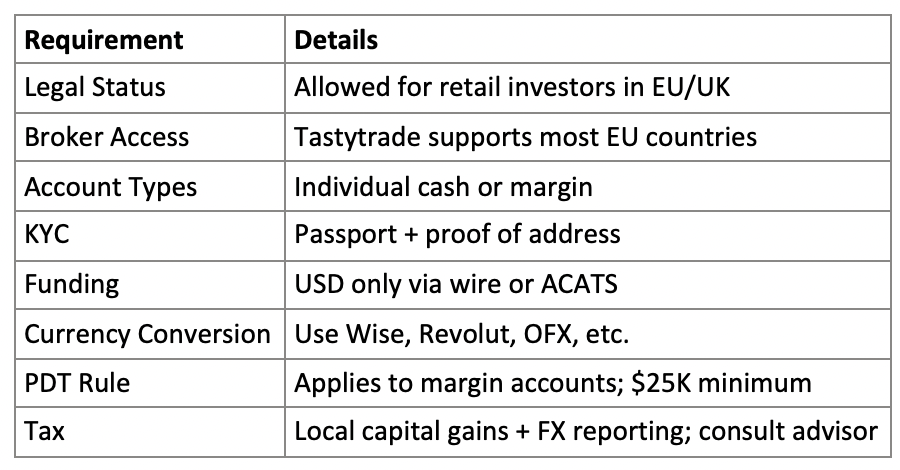

Pro Tip: Start with a cash account to avoid PDT rules and margin complexity. You can upgrade later once you're comfortable.
🌟 Why Tastytrade for Europeans? — Simple, Powerful, and Educational
Tastytrade (formerly Tastyworks) is a US-based broker built by professional options traders. It’s designed to make options trading accessible, affordable, and educational — which makes it ideal for European investors who are new to the US options market.
Here’s why it stands out:
✅ 1. Easy Account Setup for Europeans
Unlike many US brokers that restrict international access, Tastytrade accepts clients from most EU countries and the UK. The onboarding process is straightforward, with clear KYC steps and no hidden fees.
No account minimums for cash accounts
Fast online application (usually approved within 1–3 business days)
Clear document requirements (passport + proof of address)
No need for US residency or tax ID
Tip: You don’t need a US bank account — just a way to wire USD (Wise or Revolut works well).
💸 2. Transparent, Low-Cost Fee Structure
Tastytrade is known for its low commissions and no hidden fees:
Options trades: $1 per contract to open, $0 to close
Stock trades: $0 commission
No inactivity fees, no platform fees, no data fees
Example:
You sell 1 cash-secured put on AAPL: $1 commission
You close it later: $0
Total cost: $1
Pro Tip: This pricing model is perfect for income strategies like covered calls and put spreads.
📱 3. Intuitive Platform & Mobile App
Tastytrade’s platform is built for options traders — but it’s still beginner-friendly.
Visual trade builder: See your max profit/loss before placing a trade
Risk graphs: Understand your payoff scenarios instantly
Mobile app: Trade on the go with full functionality
Watchlists & alerts: Track your favorite stocks and options
Warning: The interface may feel different from CFD platforms — but once you learn the basics, it’s much more powerful.
🎓 4. World-Class Education & Support
Tastytrade isn’t just a broker — it’s also a learning hub. Their team produces daily content to help you become a smarter trader.
Free video series: Options basics, strategy deep-dives, market analysis
Live shows: Market commentary and trade ideas
Blog & help center: Step-by-step guides and FAQs
Community: Active Reddit and Discord groups
Tip: Start with their “Options Crash Course” — it’s free and designed for beginners.
🌍 5. Multi-Currency Funding (via Third-Party Services)
While Tastytrade only accepts USD deposits, you can easily convert EUR or GBP using:
Wise: Fast, low-cost currency conversion and wire transfer
Revolut: App-based FX with competitive rates
OFX: Good for larger transfers
Steps:
Convert your EUR/GBP to USD using Wise or Revolut
Send a wire transfer to Tastytrade’s funding account
Funds arrive in 1–2 business days
Warning: Always double-check wire details and fees before sending.
🧾 6. Tax-Friendly Reporting
Tastytrade provides year-end tax documents (Form 1099) for US tax purposes. As a European resident:
You don’t owe US capital gains tax
You must report gains/losses in your home country
You may need to declare foreign assets or currency gains
Tip: Keep a spreadsheet of your trades and consult a local tax advisor.
🔐 7. Safety & Regulation
Tastytrade is a member of:
FINRA (US financial regulator)
SIPC (provides up to $500,000 protection for securities)
SEC (US Securities and Exchange Commission)
Your funds are held in segregated accounts and protected under US law.
✅ Summary: Why Tastytrade Is Ideal for Europeans
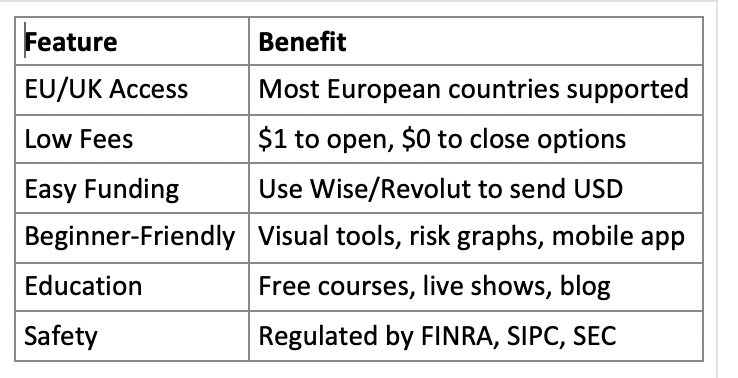

Affiliate Disclosure: We use Tastytrade personally and may earn a commission if you sign up using our affiliate link. This does not affect the content or recommendations — We only recommend tools we use.
📝 Step-by-Step Guide: Opening a Tastytrade Account from Europe
This section will help you go from zero to first trade with confidence. You’ll learn how to open your account, fund it in USD, and place your first options order — all with practical tips and warnings.
🧾 Step 1: Prepare Your Documents
Before you start the application, make sure you have:
Valid passport or driver’s license
Proof of address (utility bill, bank statement, or government-issued ID with address — less than 1 year old)
USD funding method (Wise, Revolut, OFX, or bank wire)
Tip: Scan your documents clearly and save them as PDFs or high-quality images.
🌐 Step 2: Apply Online at Tastytrade
Go to Tastytrade’s account opening page and follow these steps:
Choose Individual Account (Cash or Margin)
Select your country of residence
Fill in personal details (name, address, tax status)
Upload your documents
Agree to terms and disclosures
Warning: Double-check your country is supported. Most EU countries and the UK are eligible.
💳 Step 3: Fund Your Account in USD
Tastytrade only accepts USD wire transfers. Here’s how to do it:
Option A: Wise (Recommended)
Create a Wise account
Convert EUR/GBP to USD
Send a wire transfer to Tastytrade’s funding account (details provided after approval)
Option B: Revolut
Convert currency in-app
Use Revolut’s wire transfer feature to send USD
Option C: Bank FX Desk
Use your bank’s foreign exchange service (usually higher fees)
Tip: Always include your Tastytrade account number in the wire transfer memo.
📈 Step 4: Wait for Approval & Funding Confirmation
Account approval: usually within 1–3 business days
Wire transfer: funds arrive in 1–2 business days
You’ll receive email confirmation once your account is funded
🛠️ Step 5: Place Your First Options Trade
Once your account is funded, log in to the Tastytrade platform (desktop or mobile) and follow these steps:
Example: Selling a Cash-Secured Put on AAPL
Search for AAPL in the platform
Click “Trade” → “Options”
Choose Put Option, strike price $270, expiry 30 days
Select Sell 1 contract
Review the risk graph (shows max profit/loss)
Click “Review & Send”
Result: You collect a premium (e.g., $2 per share = $200 total). If AAPL stays above $270, you keep the premium. If it drops, you buy the stock at a discount.
📊 Step 6: Track Your Trade & Learn
Use the “Positions” tab to monitor your open trades
Set alerts for price movements
Watch Tastytrade’s daily shows for strategy tips
Pro Tip: Start with small trades and use the paper trading simulator to practice before risking real money.
Ready to try it yourself?
👉 Open your Tastytrade account and follow this guide to place your first options trade.
Disclosure: I use Tastytrade personally and may earn a commission if you sign up using my affiliate link. This does not affect my recommendations.
💰 Simple Income Strategies for Beginners (with Examples & Diagrams)
These four strategies are widely used by retail traders in the US — and they’re especially suitable for European investors starting out with Tastytrade.
Each strategy includes:
What it does
When to use it
Step-by-step setup
Real-world example
Max profit/loss
Breakeven point
Payoff diagram or table
1. 🟢 Cash-Secured Put — Get Paid to Buy Stocks
Goal: Earn income while waiting to buy a stock at a lower price.
How it works: You sell a put option and set aside enough cash to buy the stock if assigned.
Example:
Stock: Apple (AAPL) at $275
You sell a put option with a $270 strike, expiring in 30 days
Premium received: $2 per share = $200 total
You set aside $27,000 to buy 100 shares if assigned
Outcomes:
If AAPL stays above $270 → You keep the $200 premium
If AAPL drops below $270 → You buy 100 shares at $270, but still keep the premium
Tip: Great for buying quality stocks at a discount while earning income.
2. 🟡 Covered Call — Earn Income from Stocks You Own
Goal: Generate income from stocks you already hold.
How it works: You sell a call option against your stock position.
Example:
You own 100 shares of Microsoft (MSFT) at $520
You sell a call option with a $530 strike, expiring in 30 days
Premium received: $3 per share = $300 total
Outcomes:
If MSFT stays below $530 → You keep the premium
If MSFT rises above $530 → Your shares are sold at $530, but you keep the premium
Warning: Don’t use this if you want to hold the stock long-term without selling.
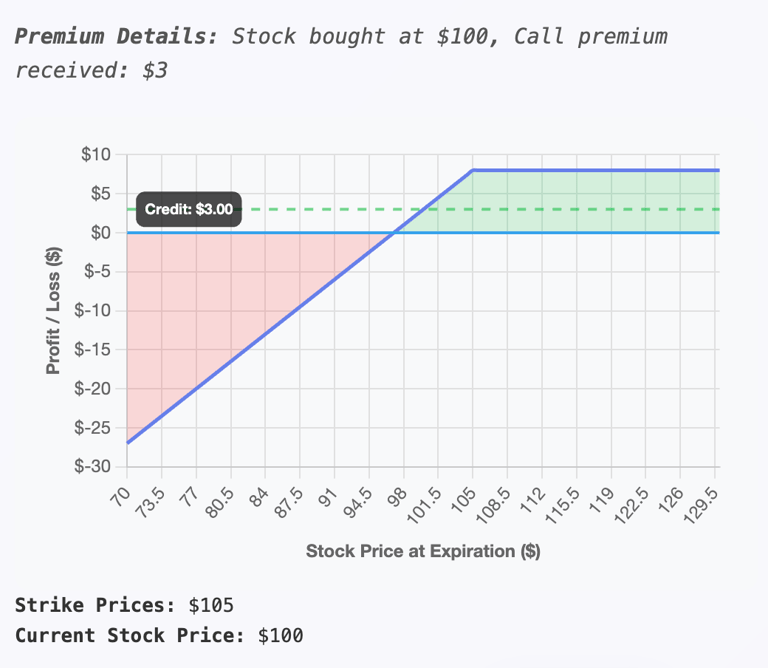

3. 🔵 Short Put Spread (Credit Spread) — Defined Risk Income
Goal: Earn income with limited downside risk.
How it works: You sell a put and buy a lower strike put to cap your risk.
Example:
Stock: NVIDIA (NVDA) at $160
Sell $150 put, buy $140 put, both expiring in 30 days
Net premium received: $1.50 per share = $150 total
Outcomes:
If NVDA stays above $150 → You keep the full premium
If NVDA drops below $140 → You lose the difference between strikes minus premium
Pro Tip: This strategy is great for small accounts and defined risk setups.
4. 🔴 Protective Put — Insurance for Your Stocks
Goal: Protect your stock from a big drop.
How it works: You buy a put option on a stock you own.
Example:
You own 100 shares of Tesla (TSLA) at $450
You buy a $440 put, expiring in 30 days, costing $4 per share = $400
Outcomes:
If TSLA drops to $420 → Your put gains $20 per share = $2,000
If TSLA stays above $440 → You lose the $400 premium
Tip: Use this before earnings or market uncertainty.
Learn more about Options Strategies Here
🧠 Risk Management & Position Sizing Rules for Europeans
Options trading offers powerful tools — but without proper risk management, it can quickly become dangerous. Here’s how to protect your capital and trade responsibly.
📏 1. Position Sizing — How Much to Risk Per Trade
A good rule of thumb: risk no more than 1–3% of your account per trade.
Example:
Account size: $10,000
Max risk per trade: $100–$300
Strategy: Sell a cash-secured put with max loss of $300 → acceptable
Tip: Use defined-risk strategies like credit spreads to cap your downside.
💱 2. Currency Risk — EUR/GBP vs. USD
Since Tastytrade accounts are in USD, European investors face currency fluctuation risk.
What to watch:
If EUR/USD weakens → your USD gains are worth more in euros
If EUR/USD strengthens → your USD gains shrink when converted
Pro Tip: Track FX rates and consider converting profits back to EUR/GBP periodically.
🌙 3. Overnight Risk & Earnings Volatility
Options prices can swing dramatically overnight — especially around earnings reports or macro news.
How to manage:
Avoid holding short options through earnings unless hedged
Use longer expiries (30–45 days) to reduce time pressure
Check IV (Implied Volatility) before entering trades
Warning: Stocks like TSLA, NVDA, and AMZN can move 5–10% overnight.
🧮 4. Strike Selection — Choosing the Right Levels
Picking the right strike price is key to balancing risk and reward.
For Cash-Secured Puts:
Choose a strike below current price (out-of-the-money)
Look for high probability of expiring worthless (Delta 0.20–0.30)
For Covered Calls:
Choose a strike above current price to allow upside
Use Delta 0.30–0.40 for decent premium without capping too early
Tip: Use Tastytrade’s platform to view probability of profit (POP) and risk graphs before placing trades.
📆 5. Expiry Selection — Timing Matters
Options expire on specific dates — usually Fridays. Choose expiries based on your goals:

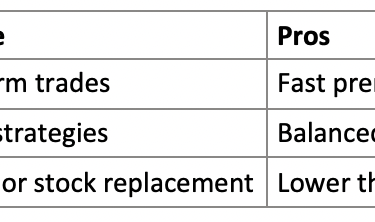
Pro Tip: For beginners, start with 30–45 day expiries — they’re easier to manage and more forgiving.
🧮 6. Margin vs. Cash Accounts — Know the Difference
Cash Account: No borrowing; only trade with settled funds. Safer for beginners.
Margin Account: Allows borrowing and advanced strategies (e.g., naked options, spreads). Requires $2,000+ and carries more risk.
Warning: Margin accounts are subject to Pattern Day Trading (PDT) rules — avoid day trading unless you have $25,000+.
Tip: Keep a trading journal to track your decisions, outcomes, and lessons learned. It’s one of the best ways to improve over time.
🧾 Taxes & Reporting — What EU/UK Traders Must Know
Trading US options from Europe can be tax-efficient, but it comes with responsibilities. While Tastytrade doesn’t withhold taxes on capital gains, you are responsible for reporting and paying taxes in your home country.
Let’s break down what you need to know.
🇪🇺 EU Tax Considerations
Each EU country has its own tax rules, but here are common themes:
Capital Gains Tax (CGT): Profits from selling options (or assigned stock) are usually taxed as capital gains.
Dividend Tax: If you’re assigned stock and receive dividends, you may owe tax on those.
Currency Gains/Losses: If you convert USD back to EUR/GBP, gains or losses from FX changes may be taxable.
Foreign Asset Reporting: Some countries (e.g., France, Spain, Italy) require you to declare foreign accounts and assets.
Tip: Keep detailed records of:
Trade dates and amounts
Premiums received/paid
USD/EUR conversion rates
Broker statement
🇬🇧 UK Tax Considerations (HMRC Guidance)
According to HMRC’s Capital Gains Manual: (gov.uk)
Selling an option: Treated as a disposal of an asset. Premium received is taxable as a capital gain.
Buying an option: If it expires worthless, the premium paid is a capital loss.
Exercising an option: The premium is added to the cost basis of the shares (for calls) or deducted from proceeds (for puts).
Cash settlement: Treated as a disposal; premium is part of the gain/loss.
Double Taxation Relief: The UK has a treaty with the US to avoid double taxation. You generally don’t pay US tax on capital gains, but you must report them to HMRC.
📋 What to Ask Your Tax Advisor
Before you start trading, ask your accountant:
Do I need to report my Tastytrade account as a foreign asset?
How are option premiums taxed in my country?
Do I owe tax on currency gains/losses when converting USD?
Can I deduct trading losses or expenses?
What forms or declarations do I need to file annually?
Are there any thresholds for reporting or paying CGT?
Do I need to register for foreign income reporting (e.g., Modelo 720 in Spain)?
Warning: Tax laws change frequently. Always consult a licensed tax professional in your country.
Pro Tip: Use Tastytrade’s downloadable trade history and 1099 forms to help with your annual tax filing. Combine this with your own spreadsheet tracking for accuracy.
✅ Practical Checklist Before You Trade US Options from Europe
Use this checklist before placing your first trade. It covers everything from account setup to strategy selection and risk controls.
📂 Account & Broker Setup
Confirm your country is supported by Tastytrade
Prepare KYC documents (passport + proof of address)
Open a cash account (recommended for beginners)
Fund your account in USD using Wise, Revolut, or bank wire
Enable 2FA for account security
Download the Tastytrade platform or mobile app
🧪 Practice & Permissions
Use the paper trading simulator to test strategies risk-free
Watch Tastytrade’s beginner videos (Options Crash Course)
Understand PDT rules if using a margin account
Check your account permissions (options level 2 or 3 for spreads)
📈 Strategy Selection
Choose a beginner strategy:
Cash-Secured Put
Covered Call
Credit Spread
Protective Put
Use risk graphs to visualize max profit/loss
Select strike price using Delta (0.20–0.40 range)
Choose expiry (30–45 days recommended)
💰 Risk & Capital Management
Risk no more than 1–3% of account per trade
Avoid trading around earnings or major news
Diversify across stocks and sectors
Track currency exposure (USD vs. EUR/GBP)
Keep a trading journal (entry/exit, rationale, outcome)
🧾 Tax & Compliance
Consult a local tax advisor
Understand capital gains tax rules in your country
Track USD/EUR conversion rates for reporting
Check if you need to declare foreign assets/accounts
Download Tastytrade tax documents annually
🧠 Mindset & Habits
Start small — one contract at a time
Focus on learning, not chasing profits
Review trades weekly and adjust strategies
Don’t trade emotionally — follow your plan
Celebrate small wins and learn from losses
Pro Tip: Print this checklist or save it as a note in your trading journal. Review it before each new trade until it becomes second nature.
📅 30-Day Beginner Plan to Start Trading US Options Safely
This plan breaks down your first month into weekly tasks. Each week builds on the last, helping you go from learning to live trading — without rushing.
Week 1: Learn the Basics & Set Up Your Account
Goals: Understand what options are, how they work, and prepare your account.
✅ Tasks:
Watch Tastytrade’s Options Crash Course
Read OraniaTech’s Options 101 Guide
Open your Tastytrade account (cash account recommended)
Prepare and upload KYC documents
Join Tastytrade’s daily live shows or YouTube
Week 2: Fund Your Account & Practice Trading
Goals: Get comfortable with the platform and test strategies.
✅ Tasks:
Fund your account via USD wire transfer
Explore the Tastytrade platform (desktop & mobile)
Use the paper trading simulator to practice:
Selling a cash-secured put
Selling a covered call
Track your simulated trades in a trading journal
Review your country’s tax rules for capital gains and foreign assets
Week 3: Place Your First Live Trade
Goals: Execute your first real-money trade with defined risk.
✅ Tasks:
Choose a beginner strategy (e.g., cash-secured put)
Use risk graphs to confirm max profit/loss
Place your first live trade (1 contract only)
Set alerts for price movements
Monitor your position daily
Review trade outcome and journal your learnings
Week 4: Refine & Expand
Goals: Build consistency and explore more strategies.
✅ Tasks:
Try a credit spread or covered call
Diversify across 2–3 stocks
Review your P&L and journal
Adjust position sizing based on results
Schedule a tax consultation or research local reporting tools
Read OraniaTech’s guide on Trading Tools for Europeans
🧠 Mindset Tips for Your First Month
Start small — one contract at a time
Focus on learning, not maximizing profits
Avoid emotional trading — stick to your plan
Celebrate consistency, not just wins
Ask questions — join communities like r/options or Tastytrade’s Discord
Pro Tip: At the end of 30 days, review your journal and identify:
What strategies felt most comfortable?
What mistakes did you make?
What will you improve next month?
❓ FAQs — Trading US Options for Europeans
1. Can I legally trade US options from Europe?
Yes. Most EU and UK residents can legally trade US-listed options through brokers like Tastytrade. There are no EU-wide bans on options trading, unlike binary options or highly leveraged CFDs.
2. Does Tastytrade accept European clients?
Yes. Tastytrade supports individual accounts from most EU countries and the UK. You’ll need to complete KYC (passport + proof of address) and fund your account in USD.
3. Do I need a US bank account to use Tastytrade?
No. You can fund your account using Wise, Revolut, or OFX to convert EUR/GBP to USD and send a wire transfer.
4. Are there any account minimums?
No minimum for cash accounts. Margin accounts require $2,000+, and day trading under margin requires $25,000+ due to the Pattern Day Trading (PDT) rule.
5. Will I pay US taxes on my trades?
Generally, no. European residents don’t pay US capital gains tax. However, you must report profits in your home country. Always consult a local tax advisor.
6. How do I report my trades for taxes?
Use Tastytrade’s downloadable trade history and tax forms (e.g., Form 1099). Track your trades, premiums, and currency conversions. Some countries require foreign asset declarations.
7. Can I use margin as a European trader?
Yes, if you fund your account with $2,000+. But margin accounts are subject to PDT rules. Beginners should start with cash accounts to avoid complexity.
8. What strategies are best for beginners?
Start with:
Cash-Secured Puts (earn income while buying stocks)
Covered Calls (generate income from stocks you own)
Credit Spreads (defined risk trades)
9. Is options trading riskier than CFDs?
Not necessarily. Options offer defined risk and more strategic flexibility. CFDs often involve built-in leverage and can lead to unlimited losses.
10. Can I trade on mobile?
Yes. Tastytrade’s mobile app is fully functional and beginner-friendly. You can place trades, view risk graphs, and monitor positions on the go.
11. Do I need to convert profits back to EUR/GBP?
Not immediately. You can keep profits in USD within your account. But when converting back, be aware of currency gains/losses, which may be taxable.
12. Where can I learn more about options?
Start with:
Tastytrade Education Hub
OraniaTech’s Options 101 Guide
Tastytrade’s YouTube channel and daily shows
🏁 Conclusion — Your First Trade & Next Steps
Trading US options from Europe is not only possible — it’s practical and empowering. With the right broker, a clear strategy, and proper risk management, you can start generating income, protecting your portfolio, and expanding your financial toolkit.
Tastytrade makes this journey easier with:
Simple onboarding for EU/UK residents
Low fees and intuitive tools
World-class education and support
Defined-risk strategies for beginners
🚀 Ready to Start?
👉 Open your Tastytrade account and follow the 30-day beginner plan to place your first options trade.
Disclosure: I use Tastytrade personally and may earn a commission if you sign up using my affiliate link. This does not affect my recommendations — I only recommend tools I use and trust.
⚠️ Final Risk Disclaimer
This Article is Not a Financial Advice!. Options trading involves risk and is not suitable for all investors. You can lose your entire investment. Always trade with defined risk, use proper position sizing, and consult a financial advisor before making decisions. Past performance is not indicative of future results.


